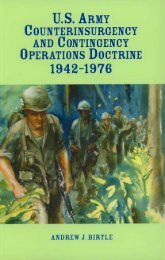C. Wiebes - Intelligence en de oorlog in Bosnië 1992-1995. De rol van de inlichtingen- en veiligheidsdiensten - Engels
C. Wiebes - Intelligence en de oorlog in Bosnië 1992-1995. De rol van de inlichtingen- en veiligheidsdiensten - Engels
C. Wiebes - Intelligence en de oorlog in Bosnië 1992-1995. De rol van de inlichtingen- en veiligheidsdiensten - Engels
- No tags were found...
Create successful ePaper yourself
Turn your PDF publications into a flip-book with our unique Google optimized e-Paper software.
213<strong>De</strong>spite this reservation there is a long history of Sig<strong>in</strong>t cooperation betwe<strong>en</strong> the Western<strong>in</strong>tellig<strong>en</strong>ce services. 1128 The <strong>in</strong>t<strong>en</strong>sive collaboration <strong>in</strong> this field dates from the Second World War,wh<strong>en</strong> the United States and the United K<strong>in</strong>gdom collaborated closely to break the German andJapanese co<strong>de</strong>s. This <strong>en</strong><strong>de</strong>avour proved highly successful and the cooperation was formalized after thewar had f<strong>in</strong>ished. On 5 March 1946 the British-United States Com<strong>in</strong>t Agreem<strong>en</strong>t was signed, op<strong>en</strong><strong>in</strong>gthe way for cooperation <strong>in</strong> the field of Com<strong>in</strong>t. In June 1948 this was superse<strong>de</strong>d by the UKUSACom<strong>in</strong>t Agreem<strong>en</strong>t. 1129Dur<strong>in</strong>g the Cold War the relationship betwe<strong>en</strong> the NSA and the other Sig<strong>in</strong>t partners, such asGCHQ and CSE, gradually <strong>de</strong>veloped to the disad<strong>van</strong>tage of the non-American services. AfterUKUSA <strong>in</strong>creas<strong>in</strong>gly started to <strong>de</strong>liver more Sig<strong>in</strong>t, on an almost <strong>in</strong>dustrial basis, the Sig<strong>in</strong>t services hadto work ever more effici<strong>en</strong>tly to process the avalanche of <strong>in</strong>tercepted signals. This was ma<strong>de</strong> possibleby a new division of tasks, the use of US technology and better and faster computers. This was noticed<strong>in</strong> the rest of Europe, and the <strong>in</strong>terest <strong>in</strong> jo<strong>in</strong><strong>in</strong>g this collaboration thus grew steadily. Various Europeancountries, such as the Scand<strong>in</strong>avian states, had started giv<strong>in</strong>g priority to Sig<strong>in</strong>t from 1950 onwards.Other countries <strong>in</strong>vested chiefly <strong>in</strong> Hum<strong>in</strong>t. The Bun<strong>de</strong>snachricht<strong>en</strong>di<strong>en</strong>st, for <strong>in</strong>stance, sp<strong>en</strong>t most of itsbudget on Hum<strong>in</strong>t at the exp<strong>en</strong>se of Sig<strong>in</strong>t.In April 1968 the famous foun<strong>de</strong>r and Head of the BND, Richard Gehl<strong>en</strong>, <strong>en</strong><strong>de</strong>d his t<strong>en</strong>ure.This was followed by a shift from Hum<strong>in</strong>t to Sig<strong>in</strong>t. The German Military <strong>Intellig<strong>en</strong>ce</strong> Service alsodrastically <strong>in</strong>creased its <strong>in</strong>vestm<strong>en</strong>ts <strong>in</strong> Sig<strong>in</strong>t from the start of the 1970s onwards. The Fr<strong>en</strong>ch<strong>Intellig<strong>en</strong>ce</strong> Service was another organization that <strong>in</strong>itially showed little <strong>in</strong>terest <strong>in</strong> Sig<strong>in</strong>t. The Dutchsituation was differ<strong>en</strong>t: from 1945 onwards major <strong>in</strong>vestm<strong>en</strong>ts were ma<strong>de</strong> <strong>in</strong> Sig<strong>in</strong>t although there wasconstant dispute about the budget and which m<strong>in</strong>istry should ‘cough up’ for it. 1130<strong>De</strong>classified American governm<strong>en</strong>t docum<strong>en</strong>ts show that from the mid-1950s onwards theUnited States and the United K<strong>in</strong>gdom conclu<strong>de</strong>d a series of bilateral agreem<strong>en</strong>ts with Norway,Austria, West Germany, Italy, Greece and Turkey. These countries are known as the Third Parties, andwere i<strong>de</strong>ally located gather<strong>in</strong>g Sig<strong>in</strong>t on the Soviet Union and the Warsaw Pact. The NSA exchangednot only <strong>in</strong>tercepts with these countries, but also <strong>in</strong>formation regard<strong>in</strong>g cryptography and cryptanalysis.Moreover, major <strong>in</strong>vestm<strong>en</strong>ts were ma<strong>de</strong> to equip certa<strong>in</strong> countries with the required ant<strong>en</strong>nas,monitor<strong>in</strong>g equipm<strong>en</strong>t and computers. The Netherlands was not among the Third Parties.However, accord<strong>in</strong>g to some publications, there was a ‘price tag’ attached to this cooperation.The <strong>in</strong><strong>de</strong>p<strong>en</strong>d<strong>en</strong>ce of the Third Parties, and also of the non-American UKUSA countries (Canada,Australia and New Zealand) <strong>de</strong>creased further with regard to Sig<strong>in</strong>t, and their <strong>de</strong>p<strong>en</strong>d<strong>en</strong>ce on the NSAbecame ever greater. The NSA asked for and received practically all <strong>in</strong>tercepts gathered by the UKUSApartners. A former Sig<strong>in</strong>t analyst of the US Air Force expressed the lopsi<strong>de</strong>d relationship betwe<strong>en</strong> theUS and Third Party countries as follows: ‘they received absolutely no material from us, while we getanyth<strong>in</strong>g they have, although g<strong>en</strong>erally it’s of pretty low quality.’ 1131 However, this was an observationfrom 1972. Has much changed?Accord<strong>in</strong>g to some authors, around 1985 the GCHQ was noth<strong>in</strong>g more than an ext<strong>en</strong>sion ofthe NSA. An <strong>in</strong>ternal GCHQ docum<strong>en</strong>t stated the follow<strong>in</strong>g, for <strong>in</strong>stance: ‘This may <strong>en</strong>tail on occasion1132the apply<strong>in</strong>g of UK [Sig<strong>in</strong>t] resources to the meet<strong>in</strong>g of US requirem<strong>en</strong>ts’. A s<strong>en</strong>ior US <strong>in</strong>tellig<strong>en</strong>ceofficial ad<strong>de</strong>d that this observation was true, ‘as it should be betwe<strong>en</strong> partners <strong>in</strong> a global <strong>in</strong>tellig<strong>en</strong>ceeffort’. In return, he observed that US resources were rout<strong>in</strong>ely committed to meet purely UKrequirem<strong>en</strong>ts. Classic example is the rout<strong>in</strong>e commitm<strong>en</strong>t of British HF <strong>in</strong>tercept capabilities to meet1128 For this section much use has be<strong>en</strong> ma<strong>de</strong> of: Matthew Aid & Cees <strong>Wiebes</strong>, ‘Conclusions’, <strong>in</strong>: Aid & <strong>Wiebes</strong> (eds.),Secrets, pp. 314-332.1129 Andrew, Presid<strong>en</strong>t’s Eyes, p. 163 and Hager, Secret Power, pp. 61-62.1130 Cees <strong>Wiebes</strong>, ‘Dutch Sig<strong>in</strong>t dur<strong>in</strong>g the Cold War, 1945-1994, <strong>in</strong>: Aid & <strong>Wiebes</strong> (eds.), Secrets, pp. 243-284.1131 ‘US Electronic Espionage: A Memoir’, Ramparts, August 1972, p. 45.1132 Richard Norton-Taylor, ‘GCHQ’s Service to US ‘Crucial’, The Guardian, 17/05/94.





